List of Authors
>>About this blog
Recent blog post
|
[Shitamachi Tom]
December 27, 2013 09:00
It's getting running low this year too. For those who are related to Chuo-ku, various memories will surely be mixed.
 When Christmas is over, we're preparing for the New Year. It's a busy year for cleaning up, preparing New Year's dishes, and busy. And how would you like to spend New Year's Eve? People who are busy preparing for the New Year until the end, those who work during the year-end and New Year holidays, and those who spend a relaxing time ... each day looks back on the year. When Christmas is over, we're preparing for the New Year. It's a busy year for cleaning up, preparing New Year's dishes, and busy. And how would you like to spend New Year's Eve? People who are busy preparing for the New Year until the end, those who work during the year-end and New Year holidays, and those who spend a relaxing time ... each day looks back on the year.
Speaking of New Year's Eve, there are many people who eat "New Year's Eve soba". Originally, "New Year's Eve" means "Setsubun", which means that on this day we prayed for sound health and ate auspicious soba. In the lunar calendar, early spring was the New Year, so the previous day's Setsubun was probably the most important thing. Later, the last day of December became "New Year", and it became established throughout the country with the introduction of the solar calendar. Nowadays, it's a feature of New Year's Eve along with the "bell of night removal".
 Actually, there is another important traditional event on New Year's Eve. This is to visit great exorcism at the shrine. It is an important ceremony that removes everyday filth and entrusts wishes for the New Year together with "Nago Shinohara" on the eve of June. It has been held since the days of Nara and Heian. On this day, we will go through the Chinowa, which will cause trouble, and cleanse ourselves. And they dedicate a doll (persongata) by entrusting them to remove the filth on their behalf. Actually, there is another important traditional event on New Year's Eve. This is to visit great exorcism at the shrine. It is an important ceremony that removes everyday filth and entrusts wishes for the New Year together with "Nago Shinohara" on the eve of June. It has been held since the days of Nara and Heian. On this day, we will go through the Chinowa, which will cause trouble, and cleanse ourselves. And they dedicate a doll (persongata) by entrusting them to remove the filth on their behalf.
In the first place, the meaning of visiting a shrine is to express appreciation for everyday blessing and to remove mistakes and filth of the body. It is said that it is not a sudden wish.
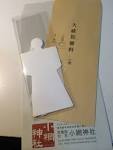 In this sense, great exorcism may be more meaningful than new year worshipping. In this sense, great exorcism may be more meaningful than new year worshipping.
There are also a number of shrines in Chuo-ku that perform this ceremony. In my case, I've been involved in this event at [Nazuki Shrine], [Tetsugunsu Inari Shrine] and [Koami Shrine]. All of them were wrapped in the dignity and strictness cultivated in history and tradition, and I felt somewhat tight.
 Why don't you visit a nearby shrine at the end of the year? Unlike the crowded grounds of new year worshipping, you can visit slowly. Why don't you visit a nearby shrine at the end of the year? Unlike the crowded grounds of new year worshipping, you can visit slowly.
Well, thank you very much for your help this year. I hope you have a good year.
[Yotaro]
December 26, 2013 09:00
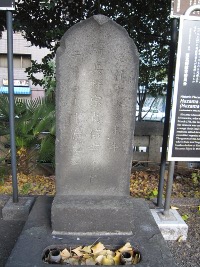 Speaking of Shiwasu, Ako Gishi was defeated, and at Kabukiza Theater, "Kanademoto Chushingura" ... one story related to Chushingura again this year. Speaking of Shiwasu, Ako Gishi was defeated, and at Kabukiza Theater, "Kanademoto Chushingura" ... one story related to Chushingura again this year.
I think many people know that one of the forty-seven men, the grave of Shinroku Hazama, is located at Tsukiji Honganji Temple. Of the forty-six people except Kichiemon Terasaka, who disappeared after the defeat, the only one Shinroku was buried outside Sengakuji. This is due to the fact that on February 4, 1703 (1703), Shinroku's son-in-law, Matasuke Nakado, who was the retainer of the late Akimoto Tajima Mamoru, took the remains from Mohri Kaimori's house where Shinroku was cut off and buried them at Tsukiji Honganji in the Chudo family Bodaiji Temple. (A tombstone will be built at Sengakuji on the 35th with other lawyers. posthumous Buddhist name is a friend of mine.
Shinroku has joined the debate with his father, Kibei (cut at Hosokawa Echinaka Mori's House) and his brother Jiro (cut at Kenmotsu Mizuno's House), so (only the three parents and children also participated.) .) There seems to be a direction that seems to be "Why only Shinroku?", But after the stomach was transported to Sengakuji Temple with a time difference in the order of Hosokawa, Mizuno, Matsudaira Okimori, and Mori family, Nakado Masuke finally went to the Hosokawa family of Kibei and the Mizuno family of Ju Jiro, but the body was already consideredMori family. In addition, it is reported that Shinroku tied Kaneko to a spear and put it in Honganji during the withdrawal of Sengakuji from Honjo Kira's residence, and asked for a memorial service, but it will be later story.
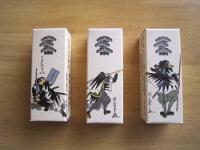 There is only one new six ... one other. The manners on the stomach was already formal at the time, and it is natural for an interrogator to drop his neck before cutting his belly, but it is said that Shinroku's assistant cut it into one letter before he shook his sword. It seems that he was a tough brother, called his brother, who was given the spear to Kira Uenosuke and was the most involved. There is only one new six ... one other. The manners on the stomach was already formal at the time, and it is natural for an interrogator to drop his neck before cutting his belly, but it is said that Shinroku's assistant cut it into one letter before he shook his sword. It seems that he was a tough brother, called his brother, who was given the spear to Kira Uenosuke and was the most involved.
The other day (the 14th), I went to the Gishi Festival at Sengakuji Temple, but there were more people than usual, so I could hardly reach the Gishi burial ground, so I gave up immediately and went to Tsukiji Honganji Temple and visited the quiet Shinroku grave.
[On the photo] The tomb of Shinroku at Tsukiji Honganji Temple, rebuilt during the Tenpo era. This posthumous Buddhist name is "Seishinshakumune Sadanobu".
[Lower photo] It was sold at "Gishi Yokan" in Shimbashi / Shinsho-do (close to the site of Tamura Ukyo Daio's House, where the inner Takumi was cut off, and famous for "in the middle of the stomach"), and at the B2F Kibikicho Square in Kabukiza . Left: Mashin Rokuro (black sugar): Kihee Hazama (salt) right: Jujiro Hazama (black sugar)
[Silver]
December 25, 2013 14:00
On December 19, for the third consecutive year, "I came to listen  to chorus by students of St. Luke's College of Nursing. to chorus by students of St. Luke's College of Nursing.
Everyone rushed during the daytime break in the rain and healed the people who visited with a clear chorus.
There are four songs that sang: "Elderly People", "Saint Night", "Akahana no Nakai", and "Santa came to town".
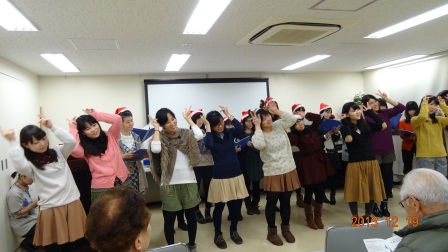
It was a really fun time when my heart was washed. Thank you for the wonderful song present.
Merry Christmas to you 
By the way, the mini health course is by dental hygienists Mayumi Takimoto and Keiko Sugiyama
The lecture was "Healthy longevity is from your mouth", and the subtitle was "Tooth energy, bone energy, brain energy".
According to the relationship between the number of remaining teeth and the total medical expenses, if the number of remaining teeth is large, the total medical expenses will be reduced.
People with healthy gums and people with more than 20 teeth are about 200,000 yen.
It was introduced that people with low teeth and diabetes cost about 310,000 yen.
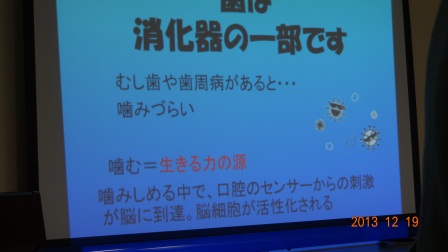
Also, in the talk about the relationship between the number of residual teeth and dementia, we are talking about the relationship between dementia.
When the teeth are low, the irritation that the chewing exercise does not have to the brain, so it is easy to develop dementia.
I've been listening seriously to the importance of keeping the oral cavity clean and to clean my tongue.
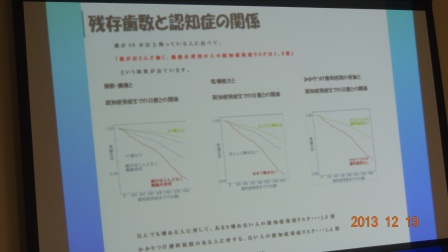
I was told that the exercise was also important, and decided to do it every day immediately.
Well, this year is a little more. Keep your precious teeth and mouth clean, eat delicious food, and have a good New Year . .
「Click here for information on "Rukanabi". http://www.kango-net.jp/project/15/
[Apricot peony]
December 24, 2013 08:30
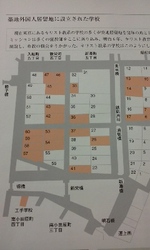
The area around Akashicho, where St. Luke International Hospital is located, was a foreign settlement in the early Meiji era.
Foreign Christianity officials who wanted to make this a foothold for missionary work sent a lot of missionaries, and there were many facilities such as "private schools" by such people in this area.
Eventually, they became "schools", and many of the current mission-based schools have designated Akashicho as the "birthplace."
Around St. Luke's College of Nursing, there are girls' schools and Rikkyo Gakuin, and around Akashi Elementary School, along the way to Kanto Gakuin, Xiaosei Gakuen, Futaba Gakuen, Tsukuda-ohashi Bridge, Meiji Gakuin, Aoyama Gakuin, Women's Seigakuin, etc. There are monuments of "birthplace" such as.
In 2013, an explanation board about the Tsukiji settlement was also built beside Akashi Elementary School.

Under such circumstances, the monument of the birthplace of `` Women's Seigakuin '' near Tsukuda-ohashi Bridge is probably due to the people involved, and in the Christmas season, red, gold and silver Christmas decorations are decorated. I am.
The care that values the place of founding no matter how many years have passed and the cute decoration like a girls' school is very wonderful, and I stop and watch every time I pass.
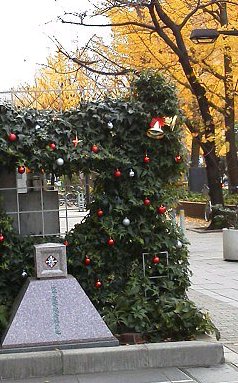 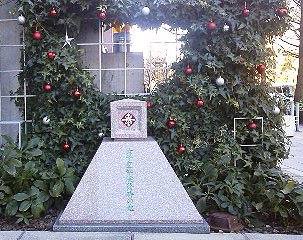
[Apricot peony]
December 11, 2013 09:00
Nanikaichi on the Tsukiji Outer Market has become an annual event.
In December, the 7th was Saturday for the first time in a long time, but it was very crowded, probably because of the influence of the special feature on Tsukiji Market on a popular TV program the day before.
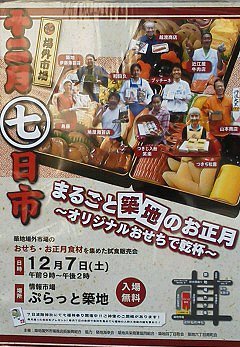 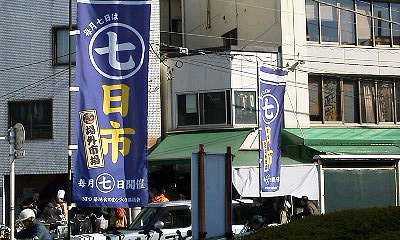
In Nanikaichi, each store offers specialty products at special prices, and at the information center "Platto Tsukiji", unique events unique to Tsukiji, such as eating and comparing eggs, are held every month.
This month of Shiwasu's "Osechi Special Feature"
From the many famous Tsukiji shops, "Matsuro" of egg-yaki, "Irifune" of Kamaboko and Datemaki, char siu from meat Oomiya, and seaweed "Hatoya", which is indispensable for rice cakes, are gathered together. Was.
The small venue was full of many people, as they could sample the specialty products of each store.
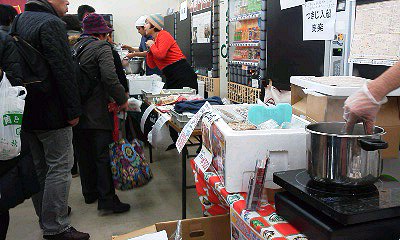 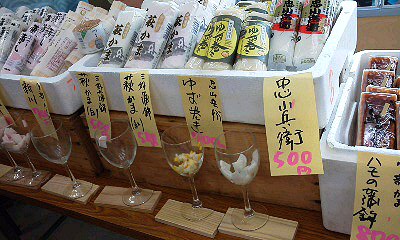
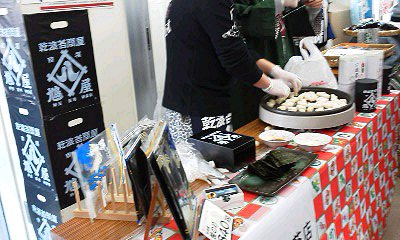 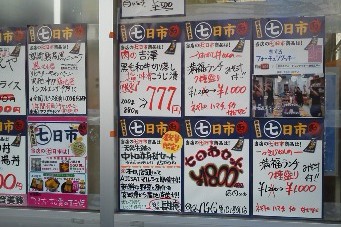
In addition, "Matsuro Sand", which is specially sold at the head office of egg-yaki "Matsuro" in the monthly Nankaichi, is already sold out after 11 o'clock!
In the past, instead of a snack to be covered, the introduction of a slightly unusual sandwich, which recreated that I was eating egg-yaki on bread, was handed over to the next time, so the shop of `` Shoro '' could be lined up Was.
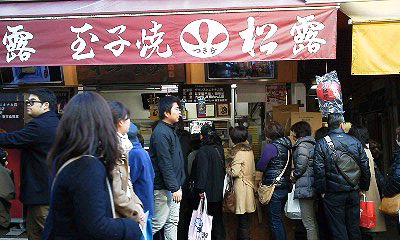
From now on, by the end of the year, more and more people will come and Tsukiji Market will be bustling.
[Silver]
09:00 on December 3, 2013
Gathering of International Exchange 2013 was held on November 16 at Tsukiji Social Education Center.
It was a very fun event, so I would like to report it to everyone.
First of all, I would like to finish the reception on the first floor and go down to each floor from the fourth floor.
The first thing I visited was Indian curry, Sri Lankan milk tea and Japanese cuisine.
I thought it was a fee, but it was all free and delicious Indian curry, kenchin zoni, and Sri Lankan milk tea. and delicious Indian curry, kenchin zoni, and Sri Lankan milk tea.
Curry was a very mild and delicious curry, with people working at Curry House Aiman in 1-2-10 Irifune, Chuo-ku serving and serving.
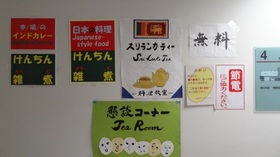 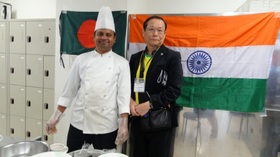
We also participated in disaster prevention corner and international exchange salon (air Japanese calligraphy experience). There was also an introduction to the sister city of Sutherland, Australia.
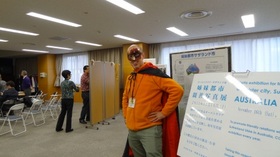 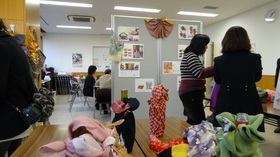
On the 3rd floor, there were ink painting, origami, furoshiki wrapping experience, tea ceremony experience, ikebana experience, dressing, etc. Everyone, it was serious, but it seemed fun.
Well, I came to the 2nd floor. Today, I've been looking forward to the Brazilian dance Samba. But I didn't check the time, so it's just over!
I re-evaluated and participated in the next Bon Odori, Salsa, in the uniform of the Brazilian national team. This was very fun, such as the Bon Dance in Edo and the coal mines.
After that, Salsa was able to dance happily with a feeling of zirva. Salsa's last song, Tchao, was a samba song, so I decided to dance all three.
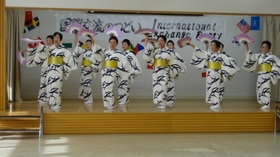 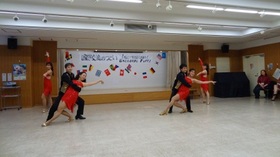
On the same 2nd floor, there was also an experience of dressing Indian costumes and sally, and young women were  shining shining  brightly. brightly.
Also, when I went up to the 4th floor again, I met a young man from Mexico who came to Japan to learn karate and Kobudo.
He was able to speak Spanish, Portuguese, English, and a little Japanese, and it was a very fun encounter.
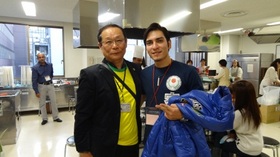
Would you like to have fun participating in international exchange?
This event of the Chuo-ku Cultural and International Exchange Promotion Association is held every year.
Also, fun events are held during the Christmas season.
The Christmas event will be held on December 14, so please check the following URL for details.
Keep watching the following URL. http://www.chuo-ci.jp/
|
Links
|
 When Christmas is over, we're preparing for the New Year. It's a busy year for cleaning up, preparing New Year's dishes, and busy. And how would you like to spend New Year's Eve? People who are busy preparing for the New Year until the end, those who work during the year-end and New Year holidays, and those who spend a relaxing time ... each day looks back on the year.
When Christmas is over, we're preparing for the New Year. It's a busy year for cleaning up, preparing New Year's dishes, and busy. And how would you like to spend New Year's Eve? People who are busy preparing for the New Year until the end, those who work during the year-end and New Year holidays, and those who spend a relaxing time ... each day looks back on the year. Actually, there is another important traditional event on New Year's Eve. This is to visit great exorcism at the shrine. It is an important ceremony that removes everyday filth and entrusts wishes for the New Year together with "Nago Shinohara" on the eve of June. It has been held since the days of Nara and Heian. On this day, we will go through the Chinowa, which will cause trouble, and cleanse ourselves. And they dedicate a doll (persongata) by entrusting them to remove the filth on their behalf.
Actually, there is another important traditional event on New Year's Eve. This is to visit great exorcism at the shrine. It is an important ceremony that removes everyday filth and entrusts wishes for the New Year together with "Nago Shinohara" on the eve of June. It has been held since the days of Nara and Heian. On this day, we will go through the Chinowa, which will cause trouble, and cleanse ourselves. And they dedicate a doll (persongata) by entrusting them to remove the filth on their behalf. In this sense, great exorcism may be more meaningful than new year worshipping.
In this sense, great exorcism may be more meaningful than new year worshipping. Why don't you visit a nearby shrine at the end of the year? Unlike the crowded grounds of new year worshipping, you can visit slowly.
Why don't you visit a nearby shrine at the end of the year? Unlike the crowded grounds of new year worshipping, you can visit slowly.


















